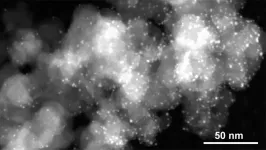(Press-News.org) In April 2021, a provision in the 21st Century Cures act took effect which required that all medical test results be released to a patient’s electronic medical record as soon as they become available.
As a result of this newer law, many patients are seeing and reading their test results even before their doctor has.
The problem is that many medical reports aren’t written with patients in mind.
For example, “a standard pathology report is written by a pathologist for a clinical specialist like a surgeon or a cancer doctor or for other pathologists to read,” said Cathryn Lapedis, M.D., M.P.H., of the Department of Pathology at University of Michigan Health.
In a published research letter in JAMA, Lapedis and her colleagues tested whether people could understand standard pathology reports and whether a patient-centered report might improve patient understanding.
“A patient-centered pathology report gives important information on the patient’s diagnosis in a clear format that minimizes medical terminology,” she explained.
“For example, a standard pathology report will include a term like prostatic adenocarcinoma, but the patient-centered report will simply call it prostate cancer."
For the study, the team recruited 2,238 adults, aged 55 to 84, who had a prostate but no history of prostate cancer.
Participants were provided with a hypothetical scenario in which they were seeking care due to troubling urinary symptoms, received a biopsy and then would receive results from that test through their patient portal.
Participants saw one of three types of reports: a standard University report identical to the format used at University of Michigan, a standard VA report identical to the format used at VA Ann Arbor Health system, or a patient-centered pathology report.
Study participants were asked to identify their diagnosis, Gleason score (a number that reports how aggressive prostate cancer is) and their risk level.
They were also asked to report their level of worry based on the results.
“We found that most people cannot get basic information—like whether or not they have prostate cancer from standard pathology reports. For example, in our participants reviewing the standard University report, only 39 percent could accurately identify that the report showed cancer,” said Lapedis.
However, 93%of those who received the patient-centered pathology report accurately identified that the report showed prostate cancer.
Furthermore, participants’ level of worry was more closely associated with their risk level (i.e. high worry with high risk vs. low worry with low risk) with the patient-centered report than the standard reports.
“We recommend that hospital systems consider including patient centered pathology reports with standard reports to improve patient understanding,” said Lapedis, adding that their team plans to study the use of patient centered reports at U-M.
Until then, Lapedis’ advice to patients about medical test results is to talk with their clinicians about what words to look for in their reports even before having the test.
Additional authors: Sophia R. Kurnot, Sarah E. Bergholtz, Scott R. Owens, Sarah T. Hawley, Todd M. Morgan and Brian J. Zikmund-Fisher.
Paper cited: “Knowledge and Worry Following Review of Standard vs Patient-Centered Pathology Reports," JAMA. DOI: 10.1001/jama.2024.25461
END
People find medical test results hard to understand, increasing overall worry
2025-01-03
ELSE PRESS RELEASES FROM THIS DATE:
Mizzou researchers aim to reduce avoidable hospitalizations for nursing home residents with dementia
2025-01-03
COLUMBIA, Mo. -- For many nursing home residents, a trip to the hospital can be a jarring experience — one that leaves them confused and stressed. Yet avoidable transfers happen far too often, not only disrupting a resident’s routine but also costing the U.S. healthcare system $2.6 billion annually.
When researchers at the University of Missouri recently looked at the decision-making process for whether or not to transfer nursing home residents to the hospital, they quickly discovered that it’s complicated — particularly for residents with cognitive impairment who may not ...
National Diabetes Prevention Program saves costs for enrollees
2025-01-03
About 1 in 3 adults in the United States have prediabetes, a condition where blood glucose levels are higher than normal, but not high enough to be diagnosed as diabetes.
Affecting 98 million adults, prediabetes can increase the risk of heart disease, stroke and type 2 diabetes.
While it can be reversed, 8 in 10 adults are unaware that they even have prediabetes.
To counter this growing problem, the National Diabetes Prevention Program was created by the Centers for Disease Control and ...
Research team to study critical aspects of Alzheimer’s and dementia healthcare delivery
2025-01-03
Kosali Simon, PhD, M.A., a professor with the Paul H. O’Neill School of Public and Environmental Affairs and a Regenstrief Institute research scientist; and Katherine Baicker, PhD, University of Chicago provost, will co-lead an expected nearly $16 million National Institutes of Health’s (NIH) National Institute on Aging (NIA) program to explore critical aspects of healthcare delivery for individuals living with Alzheimer’s disease and related dementias (ADRD).
This five-year research initiative aims to identify and address barriers to equitable and effective healthcare for this growing patient population. The ...
Major breakthrough for ‘smart cell’ design
2025-01-03
HOUSTON – (Jan. 3, 2025) – Rice University bioengineers have developed a new construction kit for building custom sense-and-respond circuits in human cells. The research, published in the journal Science, represents a major breakthrough in the field of synthetic biology that could revolutionize therapies for complex conditions like autoimmune disease and cancer.
“Imagine tiny processors inside cells made of proteins that can ‘decide’ how to respond to specific signals like inflammation, tumor growth markers or blood sugar levels,” said Xiaoyu Yang, a graduate ...
From CO2 to acetaldehyde: Towards greener industrial chemistry
2025-01-03
Acetaldehyde is a vital chemical used in making everything from perfumes to plastics. Today, its production largely relies on ethylene, a petrochemical. But increasing environmental concerns are pushing the chemical industry to reduce its reliance on fossil fuels, so scientists have been searching for greener ways to produce acetaldehyde.
Currently, acetaldehyde is produced through the so-called “Wacker process”, a chemical synthesis method that uses ethylene from oil and natural gas with other chemicals such as strong acids, i.e. hydrochloric acid. The Wacker process not only has a large carbon footprint ...
Unlocking proteostasis: A new frontier in the fight against neurodegenerative diseases like Alzheimer's
2025-01-03
Scientists have uncovered a powerful ally in the fight against neurodegenerative diseases: a nucleolar complex that plays a pivotal role in maintaining cellular health through protein homeostasis (proteostasis), by which cells maintain the balance and proper functioning of their proteins. By suppressing this complex, researchers have shown it’s possible to dramatically reduce the toxic effects of Alzheimer’s-causing proteins, boosting the cell’s natural defenses through enhanced degradation of hazardous proteins. This mechanism regulates proteostasis across tissues by modulating TGF-β signaling, a pathway involved in cell growth, differentiation, ...
New nanocrystal material a key step toward faster, more energy-efficient computing
2025-01-03
CORVALLIS, Ore. – Scientists including an Oregon State University chemistry researcher have taken a key step toward faster, more energy-efficient artificial intelligence, and data processing in general, with the discovery of luminescent nanocrystals that can be quickly toggled from light to dark and back again.
“The extraordinary switching and memory capabilities of these nanocrystals may one day become integral to optical computing – a way to rapidly process and store information using light particles, which travel faster than anything in the ...
One of the world’s largest social programs greatly reduced tuberculosis among the most vulnerable
2025-01-03
Brazil’s Bolsa Família Program (BFP), one of the world’s largest conditional cash transfer programmes, was responsible for the reduction of more than half the number of tuberculosis cases and deaths among those living in extreme poverty and indigenous groups, shows a large study coordinated by the Barcelona Institute for Global Health (ISGlobal), a centre supported by “la Caixa” Foundation, the Institute of Collective Health, and the CIDACS-FIOCRUZ in Bahia, Brazil. The findings, published in Nature ...
Surprising ‘two-faced’ cancer gene role supports paradigm shift in predicting disease
2025-01-03
UNDER STRICT EMBARGO UNTIL 10AM (UK TIME) FRIDAY 3 JANUARY 2025.
Peer reviewed | Observational study | Cells
A genetic fault long believed to drive the development of oesophageal cancer may in fact play a protective role early in the disease, according to new research published in Nature Cancer. This unexpected discovery could help doctors identify which individuals are at greater risk of developing cancer, potentially leading to more personalised and effective preventive strategies.
“We ...
Growing divide: Agricultural climate policies affect food prices differently in poor and wealthy countries
2025-01-03
“In high-income countries like the U.S. or Germany, farmers receive less than a quarter of food spending, compared to over 70 percent in Sub-Saharan Africa, where farming costs make up a larger portion of food prices,” says David Meng-Chuen Chen, PIK scientist and lead author of the study published in Nature Food. “This gap underscores how differently food systems function across regions.” The researchers project that as economies develop and food systems industrialise, farmers will increasingly receive a smaller share of consumer spending, a measure known as the ‘farm ...



